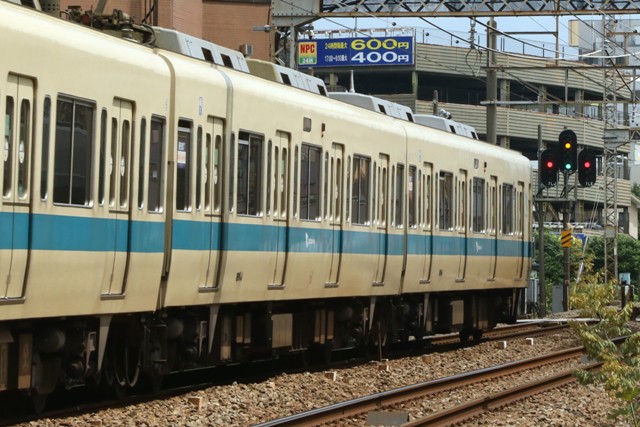There are two kinds of railway signal systems in Japan. They are the cabin signal system and the ground signal system. In the former system, the traffic signal is installed in the cabin of each train; meanwhile, in the latter system, the traffic lights are installed on the railway tracks. The cabin signal system is adopted by Shinkansens, Tokyo Monorail, Keio Electric Railway and so on; meanwhile, the ground signal system is adopted by Odakyu Electric Railway, Keikyu Electric Railway and others. In any signal system, railway companies must have ATC (Automatic Train Control) or ATS (Automatic Train Stop) devices in Japan. These devices prevent trains from overspeeding at traffic signal points, tight curves, downhill tracks and endpoints of tracks.
Odakyu Electric Railway adopts the ground signal system. You can see examples in the photos. They were taken near Sobudaimae station. There are three traffic lights on the track. From left to right, they are for the eastbound siding, the eastbound main line and the westbound main line. The red light means "stop". The green light means "advancement (maximum speed of 110 kilometers per hour)". The green plus yellow lights mean "reduced speed (maximum speed of 75 kilometers per hour)".
In the first photo, for example, the EMU 8000 series commuter train is permitted to travel on the eastbound main line at a maximum speed of 75 kilometers per hour. Needless to say, the automatic emergency brake will be applied, if the train exceeds the speed limit.
Odakyu Electric Railway adopts the ground signal system. You can see examples in the photos. They were taken near Sobudaimae station. There are three traffic lights on the track. From left to right, they are for the eastbound siding, the eastbound main line and the westbound main line. The red light means "stop". The green light means "advancement (maximum speed of 110 kilometers per hour)". The green plus yellow lights mean "reduced speed (maximum speed of 75 kilometers per hour)".
In the first photo, for example, the EMU 8000 series commuter train is permitted to travel on the eastbound main line at a maximum speed of 75 kilometers per hour. Needless to say, the automatic emergency brake will be applied, if the train exceeds the speed limit.















